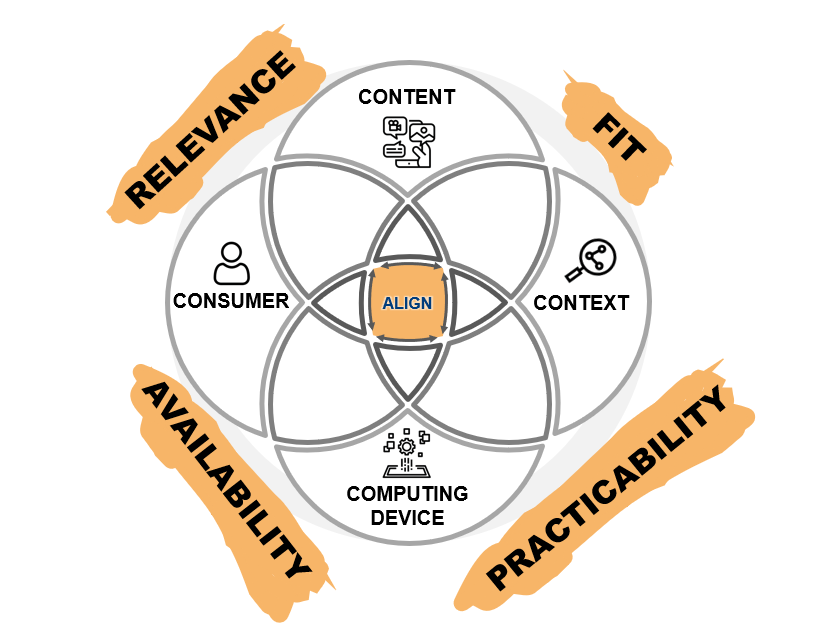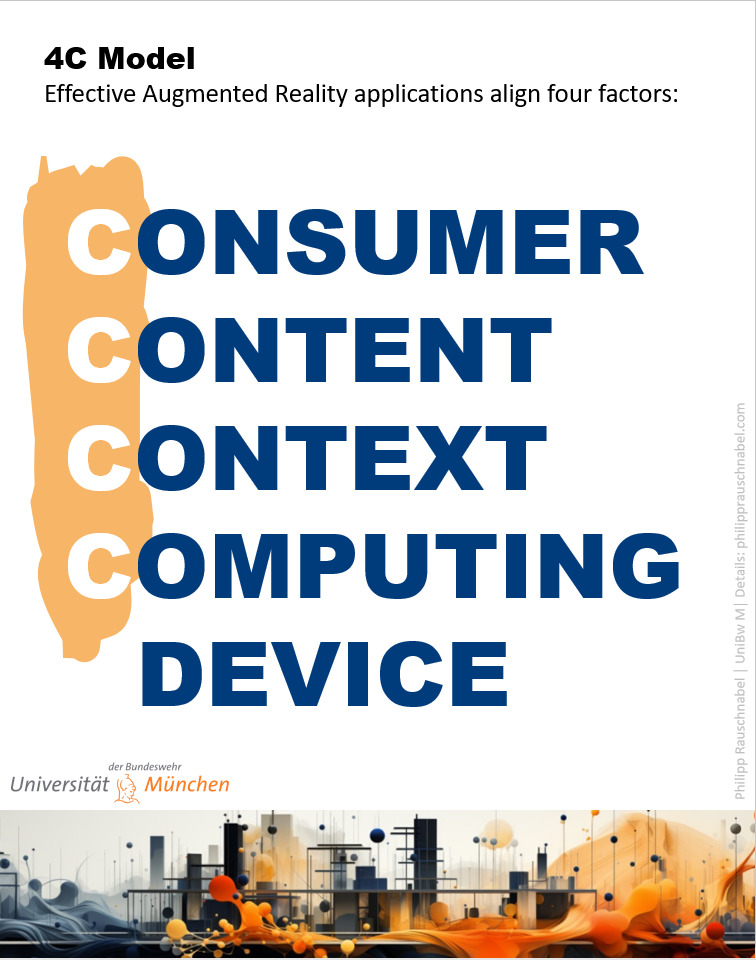In the rapidly changing world of augmented reality (AR), companies and developers need to know how to engage users. To this end, we have developed a new framework that takes into account the four elements of AR. Specifically, that a consumer embeds digital content into their physical context using a computing device. The 4Cs – Consumer, Content, Context and Computing Device – are the critical components that need to be aligned for a successful AR application. In this article, I briefly present the framework – the full paper has been published in a peer-reviewed journal and can be accessed here for free (open access)!
1. Consumer
The first “C” in the 4C framework is consumer. This element emphasizes the importance of understanding the demographics, characteristics, and experiences of the users engaging with AR. For example, different age groups and genders may have different preferences for AR content. In addition, personality traits, such as openness to experience or introversion, may influence how consumers interact with AR technology and content, the contexts in which they are commonly found, or how likely they are to purchase new devices or even use them in public contexts. The role of consumers’ knowledge and familiarity with AR is also critical, as it can significantly shape their engagement and expectations. For example, we have shown in several studies that innovative and AR-experienced consumers rate various AR-specific benefits higher and risks lower than their less experienced counterparts.
Practical Tip: Consumers
2. Content
Content is the key to determining how engaging and useful an AR experience will be. Our 4C framework divides AR content into three categories: utilitarian, hedonic, and social (and you can certainly adapt these subcategories to fit your specific needs). Utilitarian content provides practical benefits, such as helping consumers visualize products in their own space. Hedonic content is designed for entertainment and enjoyment, such as games or fun AR filters in social media apps. Social content focuses on creating or enhancing social interactions in multi-user applications or with NPCs. The mix of these content types can significantly impact consumer engagement with AR.
Consider an AR application for furniture shopping. If the content (furniture visualization) is practical and engaging, but the context (a user’s home) doesn’t align well with the device’s capabilities (like poor spatial recognition in a cluttered room), the experience will be suboptimal. Additionally, if the consumer is not tech-savvy, even the best AR content and device won’t enhance their engagement.
Practical Tip: Content
3. Context
The context in which AR is used plays a crucial role in its effectiveness. Until now, it has always been said that “content is king” – with AR, “context is king” applies just as much. Context includes the physical environment in which AR is experienced, but also the situational context (e.g. whether the environment is relaxed or hectic or what you are currently doing) and the social context. AR content that fits well in a consumer’s living room (e.g. furniture) may not work as well in a public space and vice versa – but may be perceived more realistically there. A recent study has also shown that a messy background has detrimental contextual effects on the AR experience. Different consumers are more or less likely to be in specific contexts; different contexts can also have different requirements for the computing device (e.g., handsfree use, robustness, etc.)
Practical Tip: Context
4. Computing Device
The type of device used for AR significantly affects the experience. There are stationary devices (like AR mirrors in stores), mobile devices (like smartphones and tablets), and wearables (like AR glasses). Each has its advantages and limitations. For instance, while mobile devices are widely accessible, they may offer a less immersive experience compared to wearables.
Practical Tip: Computing Device
The Importance of Aligning the 4Cs
Focusing on just one or two of the 4Cs is not enough for a successful AR experience. For example, even if the content is engaging (Content), but the device used (Computing Device) is inconvenient or not widely accessible, the overall experience may suffer. Similarly, excellent content and device compatibility will fall short if they do not align with the user’s personality or the context in which they are used.
In conclusion, the 4C framework highlights the need for a holistic approach to AR, emphasizing the interplay and alignment of Consumer, Content, Context, and Computing Device. By understanding and integrating these elements, businesses and developers can create more engaging, effective, and user-friendly AR experiences.

How can you use the 4C-Framework?
- When designing AR scenarios, make sure you consider all 4Cs
- If someone tells you that XYZ is a success factor for AR, remember: It may also depend on the other 3Cs. There is no one-size-fits-all solution
- If you teach XR, discuss case studies along the 4Cs
- If you are researching users in AR, use the 4Cs to build your hypotheses
- When looking for a research topic, consider the overlap between two, three, or all four Cs
- When reporting AR research design, report all relevant aspects across all 4Cs
Further Reading
von der Au, S., Rauschnabel, P. A., Felix, R., & Hinsch, C. (2023). Context in augmented reality marketing: Does the place of use matter?. Psychology & Marketing.

Philipp A. Rauschnabel, Reto Felix, Jonas Heller, Chris Hinsch,
The 4C framework: Towards a holistic understanding of consumer engagement with augmented reality,
Computers in Human Behavior,
2023,
108105,
ISSN 0747-5632,
https://doi.org/10.1016/j.chb.2023.108105.
(https://www.sciencedirect.com/science/article/pii/S0747563223004569)